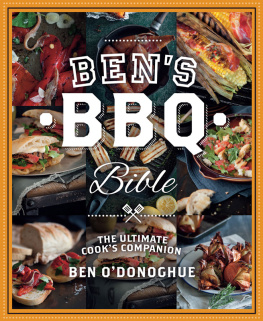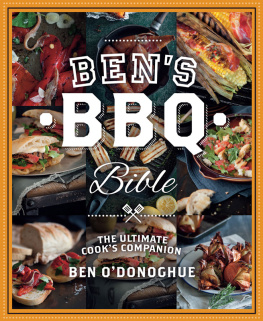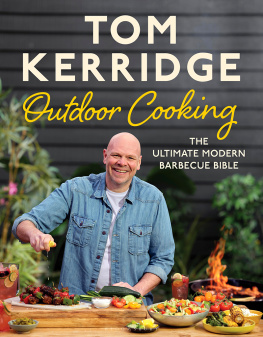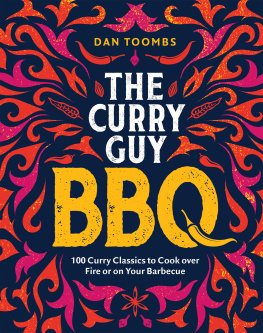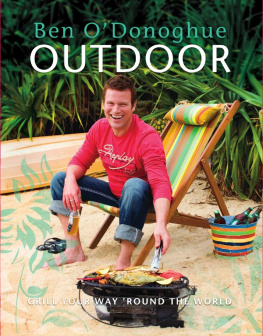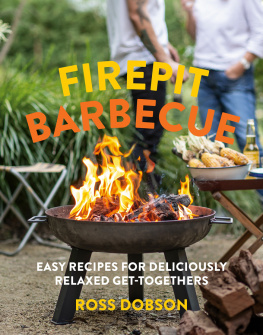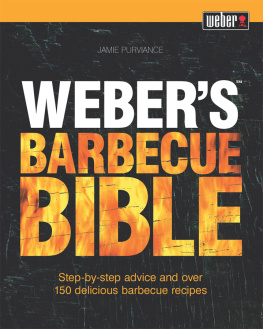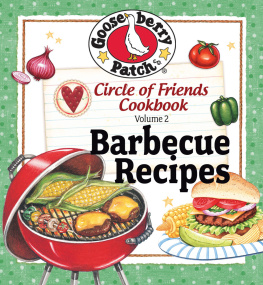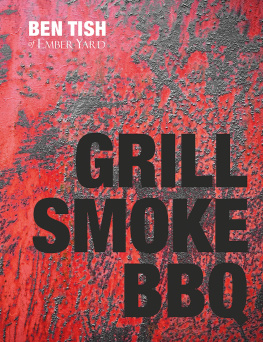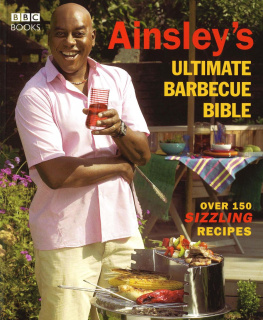CONTENTS
INTRODUCTION
There is no doubt that I love a barbecue. Its a style of cooking that continues to touch every culture, bringing people together all around the globe, and a social occasion that releases any sense of inhibition about ones ability to cook everyone thinks they are a master!
According to the learned American gentleman Jonathan Daniels (190281), Barbecue is a dish which binds together the taste of both the people of the big houses and the poorest occupants of the back end of the broken-down barn. Barbecues not only cross social and economic barriers, they also break down geographical and cultural boundaries. Every nation around the world has a form of barbecue, or certain types of food that are specifically cooked on one.
Barbecuing is a cooking technique some would say an art form that can be performed just about anywhere: in restaurants and backyards, in parks, at beaches or on street corners. The basic requirements are so simple, a barbecue can be fashioned from just about any raw materials you have to hand. I have seen shopping trolleys, terracotta planter boxes, metal garbage cans, roof sheeting, plough wheels you name it. If you can build a fire in it, on it or under it, then you can have a barbecue. Whether youre talking about the hangi pits of New Zealand and Polynesia, the braziers in Moroccos souks, the blazing heat of a gauchos grill, the pit masters of the southern states of America, the barbecue kings of the Antipodes or the street stallholders of Asia, the common denominator is always fire.
Fire, or more specifically, charcoal, lends a desirable flavour to food, and there is a primeval sense of security and accomplishment that comes from building a bonfire and cooking something in the flames. I well remember childhood memories of going down to the beach on early-morning fishing expeditions with my friends, building a fire and throwing our fresh catch onto the coals, the charred results leaving us utterly replete.
This initial foray into cooking led me down my professional path, and it was these childhood memories, combined with my more recent global wanderings and discussions with taxi drivers, kitchen porters and fellow barbecue aficionados, that prompted me to write this book.
Barbecues origins lie in the Caribbean with the indigenous Taino, whose barabicu was a form of pit cooking using green pimento tree branches and leaves, which imparted their flavour to the food. The word barbacoa was used by the Mesoamerican people of Mexico, and it is generally accepted that the word we use today made its way into popular usage via Texas, which was once part of Mexico.
In most parts of the world, to barbecue means to directly grill food over hot coals or gas. In the US, however, it refers to a form of slow, indirect cooking thats more in keeping with the tradition of pit cooking. Common to all methods is the fact that a barbecue is undeniably the most social and relaxing form of cooking and entertaining.
With the advent of new fuels and construction materials, the modern barbecue has come a long way from that classic backyard feature, the wood-burning barbecue usually constructed from a couple of bricks and a rusty metal grill, or a 44-gallon barrel cut in half with thick metal mesh thrown over the top. These days, the barbecues we cook on are the compact designer models, ideal for apartment dwellers; hooded gas barbecues, with all their bells and whistles; kettle barbecues, with their rounded, domed design and useful lid; and those ineffectual electric barbecues found in public parks and picnic areas.
This book is a celebration of the barbecue and its global idiosyncrasies. All the classics are here, along with recipes Ive re-invented and my own personal favourites. I have cooked or eaten all of these fabulous recipes while exploring and enjoying the diversity of the barbecue world. I hope you enjoy them as much as I do.
EQUIPMENT AND TIPS
The keys to a successful barbecue are preparation and some level of organisation. Whether youre attempting a major gastronomic event or just grilling a few steaks, there are a few things you need to remember.
Before you start thinking about whether youre doing T-bones, brisket, satay or squid, the first and most important thing to keep in mind is the golden rule: make sure you have enough fuel!
Other important rules when barbecuing are:
Never leave your post
Never hand the tongs to someone you cant trust
When smoking, always remember: if youre looking, youre not cooking
Also when smoking, what you need is a thin stream of smoke, not a great big cloud!
There are two basic methods of cooking on a barbecue:
Direct grilling involves exposing food directly to the heat source, using a skewer, grill or griddle. Its generally a fast way of cooking, and some people in the barbecue world consider it heresy!
Indirect cooking uses heat transfer via convection. Generally, the heat source is set away from the food, so its a slower way to cook. Hot, smoky air passes through an enclosed container, whether using the hood of a gas barbecue, the lid of a kettle barbecue or, as in the US where this style of barbecuing is most common, an entire trailer converted into an oven that can hold a whole pig! Some barbecue experts consider the flavour and tenderness of meat cooked this way to be far superior to directly grilled meat.
FUEL
The most popular barbecues on the market are the hooded gas and charcoal-fuelled kettle models, which can be used to cook either indirectly or directly. The main difference between gas and charcoal fuel is the fact that gas burns colder than charcoal. This means it provides a lower cooking temperature than briquettes, charcoal or wood, which with the addition of oxygen (i.e. a fan) can burn hot enough to melt metals! Purists will say that the flavour gained from the use of charcoal is far superior, both in terms of smokiness and the high heat thats achieved to sear the meat. Gas, on the other hand, is cleaner and far more time efficient. Now that a range of woodchips for flavouring barbecues is available, the argument for coal over gas has no clear winner, the choice being merely one of tradition or modernity.
So, you have your hardware now what else do you need? Youll probably have most of the following in your kitchen, but remember that preparation is everything and can make or break your barbecue.
Enough fuel (gas, charcoal or briquettes)
Lightweight long-handled tongs
A roasting fork for turning large joints of meat and lifting delicate fish fillets
A long-handled spatula with a cutting edge
Leather or thick gloves for handling hot metal
Oven or barbecue mitts
Plenty of paper towels
A selection of sharp knives: a 23 cm chefs knife for chopping, a long-bladed boning knife for boning and filleting fish and meat, a paring knife for fruit and vegetables and a diamond steel to keep them sharp!
A basting needle or brush (needles are good because they dont singe)
Long metal skewers for kebabs and trussing poultry and fish
Wooden skewers (these need to be soaked in water for an hour before using, so they dont burn on the grill)
A fish basket for grilling whole fish
Foil or qbags (an aluminium foil bag)
Foil drip trays
A roasting stand for large joints and birds
A large, heavy cast-iron roasting tray
A wire rack or cake rack to place over the roasting tray
Selected woodchips (oak, mesquite, hickory, apple or your personal favourite), pre-soaked in water for an hour

